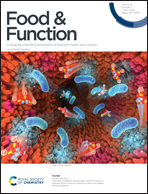Genotype and ripening method affect carotenoid content and bio-accessibility in banana†
Abstract
Bananas (Musa spp.) are a target crop for provitamin A carotenoids (pVACs) biofortification programs aiming at reducing the negative impact on health caused by vitamin A deficiency in vulnerable populations. However, studies to understand the effect of ripening methods and stages and the genotype on carotenoid content and bioaccessibility in the banana germplasm are scarce. This study evaluated carotenoid content and bioaccessibility in 27 different banana accessions at three maturation stages and two ripening methods (natural ripening and ethylene ripening). Across most accessions, total carotenoid content (TCC) increased from unripe to ripe fruit; only two accessions showed a marginal decrease. The ripening method affected carotenoid accumulation; 18 accessions had lower TCC when naturally ripened compared with the ethylene ripening group, while nine accessions showed higher TCC when ripened with exogenous ethylene, suggesting that treating bananas with exogenous ethylene might directly affect TCC accumulation, but the response is accession dependent. Additionally, carotenoid bioaccessibility varied across genotypes and was correlated with the amount of soluble starch and resistant starch. These findings highlight the importance of ripening methods and genotypes in maximizing banana carotenoid content and bioaccessibility, which could contribute to improving pVACs delivery in biofortification programs.



 Please wait while we load your content...
Please wait while we load your content...